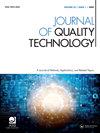Advanced Survival Models
IF 2.2
2区 工程技术
Q2 ENGINEERING, INDUSTRIAL
引用次数: 0
Abstract
Presenting a thorough review of selected topics in survival analysis, Dr. Legrand’s Advanced Survival Models is an excellent reference for students and/or practitioners. The book covers four advanced topics: frailty models, cure models, competing risks, and joint modeling of time-dependent covariates. Each topic is addressed with great care, balancing coverage with intimate detail so that readers come away with a comfortable level of knowledge about each topic. The book is divided into six chapters. The first chapter covers basic survival analysis concepts and presents six medical datasets (many of which are publicly available) for illustrating the models going forward. Each dataset is explained in great detail, including the context of data collection and the meaning of each variable. The data are analyzed using primarily R code throughout with a sprinkling of SAS code as well. The second chapter then presents a brief review of classical survival analysis techniques. It is in this chapter that readers get a taste of the level of detail with which Dr. Legrand discusses each of the advanced models: parametric models, semi-parametric models, non-parametric models, Cox proportional hazards, accelerated failure time; all are given their due diligence and illustrated with the data provided, so that the reader is presented with the breadth of methodology available at even the basic level. For the remaining four chapters, the format is similar. The chapter opens with an overall introduction of the topic, effectively summarizing the contents to come. Next, the primary model varieties are presented with sufficient context to understand their origins as well as their areas of appropriate use. Next, the primary methods of estimating the models are discussed. Finally, the chapter ends with illustration of the models using one or more of the datasets. In each case, Dr. Legrand presents enough detail so that the reader becomes intimately familiar with the basic concepts and estimation procedures. As an illustration of her effectiveness, I was not aware of the existence of cure models prior to reading this book. Now, I feel confident enough on the subject that I would be comfortable explaining it to another person. Where there is the opportunity for more specialized models and/or estimation procedures, multiple references are provided that discuss such models and/or procedures in greater detail. I found the references satisfactory for further study on a particular topic. While the book overall is a fairly easy read, there are several editorial “glitches” that, though not sufficient to cause confusion and misunderstanding, were still noticeable and tended to happen more frequently than one would expect. Most of these “glitches” consist of typographical errors and awkward sentence structures. In addition, the material was a bit repetitive when moving from the introduction to the main material in each chapter. However, I consider both of these to be very minor inconveniences as neither detracted from my understanding of the material. In conclusion, I consider this book an invaluable reference for any practitioner or researcher in survival analysis. I could also see it as an excellent text for graduate students. I am very much grateful for Dr. Legrand’s work in bringing knowledge of these advanced models to the statistical community.高级生存模型
Legrand博士的《高级生存模型》对生存分析中选定的主题进行了全面的回顾,是学生和/或从业者的极好参考。该书涵盖了四个高级主题:脆弱性模型,治疗模型,竞争风险,以及时间相关协变量的联合建模。每一个主题都是非常小心的,平衡覆盖与亲密的细节,让读者带着一个舒适的知识水平离开每个主题。这本书分为六章。第一章涵盖了基本的生存分析概念,并提供了六个医疗数据集(其中许多是公开的)来说明未来的模型。每个数据集都有非常详细的解释,包括数据收集的上下文和每个变量的含义。数据的分析主要使用R代码,同时也使用少量的SAS代码。第二章简要回顾了经典的生存分析技术。正是在这一章中,读者可以体会到Legrand博士讨论每个高级模型的详细程度:参数模型、半参数模型、非参数模型、Cox比例风险、加速故障时间;所有这些都给予了他们的尽职调查,并与所提供的数据进行了说明,以便读者能够在基本水平上获得广泛的方法。其余四章的格式类似。本章以对主题的总体介绍开始,有效地总结了接下来的内容。接下来,介绍了主要模型品种的充分背景,以了解它们的起源以及它们的适当使用领域。其次,讨论了模型估计的主要方法。最后,本章以使用一个或多个数据集的模型说明结束。在每种情况下,Legrand博士都提供了足够的细节,以便读者能够非常熟悉基本概念和估计过程。为了说明她的有效性,在阅读这本书之前,我并不知道治疗模型的存在。现在,我对这个话题有足够的信心,我可以放心地向另一个人解释。在有机会使用更专门化的模型和/或评估过程的地方,提供了更多的参考资料来更详细地讨论这些模型和/或过程。我发现这些参考文献对某一特定主题的进一步研究是满意的。虽然这本书总体上读起来相当容易,但有几个编辑上的“小故障”,虽然不足以引起混淆和误解,但仍然很明显,而且发生的频率往往比人们预期的要高。这些“小故障”大多由排版错误和笨拙的句子结构组成。此外,从每章的引言到主要内容的转换过程中,材料有一点重复。然而,我认为这两个都是非常小的不便,因为它们都不会影响我对材料的理解。总之,我认为这本书对任何生存分析的实践者或研究者来说都是无价的参考。我也认为这是一本很好的研究生读物。我非常感谢勒格朗博士将这些先进模型的知识带入统计界。
本文章由计算机程序翻译,如有差异,请以英文原文为准。
求助全文
约1分钟内获得全文
求助全文
来源期刊

Journal of Quality Technology
管理科学-工程:工业
CiteScore
5.20
自引率
4.00%
发文量
23
审稿时长
>12 weeks
期刊介绍:
The objective of Journal of Quality Technology is to contribute to the technical advancement of the field of quality technology by publishing papers that emphasize the practical applicability of new techniques, instructive examples of the operation of existing techniques and results of historical researches. Expository, review, and tutorial papers are also acceptable if they are written in a style suitable for practicing engineers.
Sample our Mathematics & Statistics journals, sign in here to start your FREE access for 14 days
 求助内容:
求助内容: 应助结果提醒方式:
应助结果提醒方式:


